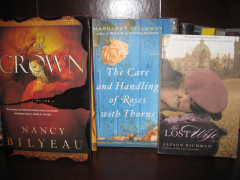Erika Robuck's Blog, page 19
February 12, 2013
Book Review: THE LAST RUNAWAY
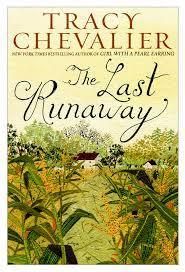
“As she watched, the darkness unfolded itself, stood and took the shape of a young black woman, barefoot, in a yellow dress. Around her hair she wore a strip of cloth torn from the hem of her dress…[S]he held out a hand towards Honor. A small, ambiguous gesture, it still had the power to untwist Honor’s stomach, for it said: Help me.” Tracy Chevalier, THE LAST RUNAWAY
Tracy Chevalier’s THE LAST RUNAWAY was published in January and is 338 pages. I received a copy for review because of my ongoing interest in Chevalier’s work, and this book might now be my favorite of her novels.
THE LAST RUNAWAY begins on a gangplank in Bristol, England as Quaker Honor Bright prepares to leave for America with her sister, Grace. Honor has been jilted in love, and her devotion to Grace and the idea that she “can always go back” inspires her to travel with her sister aboard the Adventurer to Ohio, where Grace’s betrothed waits for her.
It doesn’t take long for tragedy to befall Honor, and she finds herself alone in an undeveloped world, reliant upon her talents and the aid of strangers. From outspoken milliners, to complicated slave hunters, to the Quakers who are supposed to welcome her, and the runaway slaves she’s supposed to leave alone, Honor finds that nothing is as it seems. Surprised by Americans and herself at every turn, Honor is forced to either betray her conscience or those around her.
THE LAST RUNAWAY is the kind of novel that draws the reader in, as if inviting one to hear a story or a bit of gossip, and doesn’t release its grip until the final shocking pages. Historically fascinating and unpredictable, the tension in the novel grows until it becomes nearly unbearable. All the while, the kind and steady voice of Honor Bright is a beacon. Her journey is one that is vast and satisfying, and shows both her self and the reader her incredible strength of character.
If you enjoy original and enlightening historical fiction populated by unforgettable players, I recommend THE LAST RUNAWAY. Long time Chevalier fans will gain a new appreciation for the author they have grown to return to over and over again from this intense and thought-provoking story.
Because I enjoyed THE LAST RUNAWAY so much, I’ll be sponsoring a giveaway that runs through this Friday, 2/15, at midnight, EST. Please comment about this or your favorite Chevalier novel for a chance to win, and please spread the word.
February 7, 2013
Book Review: NO ONE IS HERE EXCEPT ALL OF US
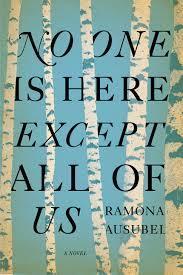
“Even though you have only been alive a few days, your story, our story, started a long time ago. Ours is a story I know, both the parts I saw with my eyes and the parts I did not. This kind of knowing comes from somewhere in my bones, somewhere in my heart. Someday, your children will ask what happened, and you will tell a new version, and this way, the story will keep living. The truth is in the telling.” Ramona Ausubel, NO ONE IS HERE EXCEPT ALL OF US
NO ONE IS HERE EXCEPT ALL OF US, by Ramona Ausubel, was published on February 5th and is 405 pages. I received a review copy from the publisher, Riverhead/Penguin, for consideration, and I’m glad I did. It was a heartbreaking literary masterpiece.
Set in a remote village in Romania in 1939, NO ONE IS HERE EXCEPT ALL OF US tells the story of nine Jewish families who make a brave and unusual decision when the encroaching effects of the Nazi’s campaign across Europe arrive in the form of a nearly drowned woman. This stranger tells of an evil army who has tortured and murdered everyone she loves, and the villagers recognize their own danger.
Together, they decide to reinvent themselves. Husbands and children are exchanged, jobs are swapped, and religious worship is reimagined. In their naivete, they convince themselves that if they recreate their myths and stories, they will begin the world again and protect themselves from outside threats.
For a period of time, their grand experiment seems to work, but the smallest action of remembrance suddenly invites the outside world in at a greater rate than it can be held out. What ensues is destruction, betrayal, and devastation, but also, great opportunities for courage, self-sacrifice, and hope.
This novel is a treasure. Ausubel’s voice is unique and evocative. Words are arranged to convey layers of meaning rich in symbol and history. Each paragraph holds weight. It cannot be read quickly, and to do so would do the prose a disservice. Once the reader enters this world, even if she wants to leave she will be held captive by the bazaar behaviors, honest feelings, suspenseful action, and ultimate destination of the book.
NO ONE IS HERE EXCEPT ALL OF US made me feel the crimes against humanity so often written about during the second World War in new ways, ways that cut deeper than ever before, and yet always kept a persistent, lingering hope. Sometimes it is elusive and seems as if it will never return, but Ausubel, a master storyteller, knows just when to give the reader relief.
The last time I felt this strongly about a book was when I read THE ROAD by Cormac McCarthy. Both of these books broke my heart over and over, but the small shaft of redemption made the pain worthwhile.
If you enjoy literary novels that challenge your emotions and engage your imagination in new ways, I highly recommend NO ONE IS HERE EXCEPT ALL OF US. It is one of the most powerful and moving books I’ve ever read, and I think book clubs, in particular, would gain much from reading and discussing it.
January 21, 2013
Book Review: THE STORY OF BEAUTIFUL GIRL
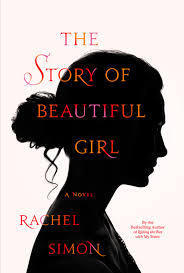
“This much she knew: She had begun to change last night. She had climbed to the attic, and sat beside the baby, and thought, I am all you have now. And she’d felt an opening in her chest where she hadn’t known anything was closed.” Rachel Simon, THE STORY OF BEAUTIFUL GIRL
Rachel Simon’s THE STORY OF BEAUTIFUL GIRL is 340 pages and was first published in 2011 in hardcover. It is now out in paperback, and was recommended to me by my critique partner, Jennifer Lyn King. She must know me very well, indeed, because I enjoyed it thoroughly.
The novel begins on a night in 1968, when a widow, alone in her farmhouse, meets two strangers at her door. The mute white woman and the deaf African-American man are on the run, and clearly frightened. The widow, Martha, soon learns that the young woman, Lynnie, has just given birth to a baby girl, and as the authorities from the School for the Incurable and Feebleminded come to take them back to the institution, Lynnie is able to utter two words to Martha that forever change all of their worlds:
“Hide her.“
THE STORY OF BEAUTIFUL GIRL spans the next four decades as Martha responds to a call that asks so much more of her than she ever thought herself capable. It traces the lives of those who were institutionalized in the sixties and beyond, who were often treated poorly, and who sometimes had far more intelligence and ability than their caretakers understood. It shows the tests and triumphs of adversity, and the results of a lifetime of hope.
Like Martha, the reader will feel the expansion of her heart and capacity for empathy and understanding growing while she reads the novel. THE STORY OF BEAUTIFUL GIRL is one of those rare books that while portraying human darkness, stunningly illustrates the capacity we have to love. This book broke and healed my heart many times over, and I was left with a new understanding of those with developmental disabilities or differences that has changed me.
I can’t overstate how much our society needs books like THE STORY OF BEAUTIFUL GIRL. In this culture of death, violence, and the objectification of human persons, novels like this that touch the reader on such an emotional level have real power to heal broken places in our world. If you have not yet read this outstanding work of fiction, I highly recommend THE STORY OF BEAUTIFUL GIRL.


January 14, 2013
Book Review: THE AVIATOR’S WIFE
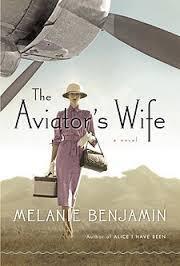
“Even now, I think of flying as a refuge; gliding with the birds on the currents, the sky a great silent cathedral surrounding you. And although I know differently–my ears sometimes ring with the memory of the roaring of those early engines–I imagine him crossing the ocean in silence, a young man, his hand on the control stick and his foot on the rudder, alone with just his thoughts; for the first and only time in his life, free from expectations. Free from the burden of living up to the legend that awaits him a mere twenty or so hours away, in a primitive airfield just outside of Paris.” Melanie Benjamin, THE AVIATOR’S WIFE
THE AVIATOR’S WIFE by Melanie Benjamin was released today and is 396 pages. I loved Benjamin’s first historical novel, ALICE I HAVE BEEN, so I was eager to read her latest, and picked up an ARC at a book festival.
Benjamin’s novel is the epic story of Anne Morrow Lindbergh, wife of the first man to fly solo across the Atlantic, Charles Lindbergh, and the joys and tragedies of their long marriage, including the kidnapping of their son. Like many women of her time, Anne’s role is considered in tandem to the men in her life. She is the ambassador’s daughter until she becomes the aviator’s wife, and then the mother of the aviator’s children. It isn’t until she survives some of her own remarkable achievements and true tragedy that she begins to emerge from the shadow of those around her.
From the opening chapters of the book when young Anne meets the serious and mysterious young pilot, Lindbergh, and becomes his flying crew on his many travels, I was spellbound. The period detail, the incredible tales of adventure Anne and Charles faced in their early marriage–including the relentless hounding of the paparazzi–and the devastating abduction of their eighteen-month-old son, make THE AVIATOR’S WIFE impossible to put down. Anne is a dynamic and likable protagonist who struggles to balance the need to forge her own identity while staying loyal to her husband. She makes mistakes along the way, but her self-knowledge and loyalty become the very traits that account for her literary successes and eventual claim on her life and its definition.
From plane crashes, to Nazi Germany, to the literary scene in New York, THE AVIATOR’S WIFE is a multi-generation novel that book clubs and readers of historical fiction will devour. Fans of THE PARIS WIFE and LOVING FRANK have a new story to add to their list of favorites. I give THE AVIATOR’S WIFE my highest recommendation, and because I loved it so much, I’m hosting a giveaway. Please comment below by midnight on Thursday, January 17th for a chance to win, and please spread the word. The winner will be announced on Friday, January 18th.
January 8, 2013
Book Review: THE PLUM TREE
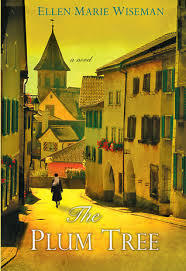
“For seventeen-year-old Christine Bolz, the war began with a surprise invitation to the Bauermans’ holiday party. On that brilliant fall day in 1938, it was impossible to imagine the horrors to come.” Ellen Marie Wiseman, THE PLUM TREE
Ellen Marie Wisemen’s novel, THE PLUM TREE, was published in December of 2012, and is 304 pages. Ellen is in my writer “support” group, Book Pregnant, and I’ve been following her process with interest because of my enthusiasm for historical fiction.
Set in Germany during the second world war, THE PLUM TREE, is the story of a young, poor, Christian woman who falls in love with her wealthy employer’s son, a young, Jewish man named Isaac. As their secret love blooms, Hitler’s dark shadow begins to spread over the land by way of anti-semitic posters, propaganda, and oppressive laws, including the Nazi proclamation that Christians could no longer work for Jews.
Torn apart as their love is just beginning to bloom, Christine and Isaac believe their bond cannot be broken by physical separation alone, and vow to find each other after the war. But as the increasing horrors of living in war-time Germany build, Christine and Isaac find themselves facing the unimaginable hell of the Nazi concentration camps, where every moment of every day means the difference between life and death, survival and destruction.
THE PLUM TREE is powerful and highly evocative. Memorable and honorable characters populate its pages, and Wiseman provides a window into the lives of ordinary German citizens as horror struck by the Nazis as the rest of the world. Her attention to research and historical detail is clear and fascinating, and I learned so much about the German people at that time that I’d never known. Christine and Isaac are worthy protagonists, facing hardship with humanity, determination, and vast but believable courage, and the portrayal of the bonds of family in THE PLUM TREE is particularly moving.
It’s no easy task to write a novel set during the second World War that explores new territory with characters of the greatest worth and hope, but Wiseman has done so to great effect. I was moved to tears many times during THE PLUM TREE, and its characters will stay with me long after I’ve finished reading the book. If you enjoyed Tatiana de Rosnay’s SARAH’S KEY or Jenna Blum’s THOSE WHO SAVE US, you will love THE PLUM TREE. I give it my highest recommendation.
December 30, 2012
2012 in review
The WordPress.com stats helper monkeys prepared a 2012 annual report for this blog.
Here’s an excerpt:
600 people reached the top of Mt. Everest in 2012. This blog got about 10,000 views in 2012. If every person who reached the top of Mt. Everest viewed this blog, it would have taken 17 years to get that many views.
Click here to see the complete report.


December 29, 2012
Book Review: The Sealed Letter
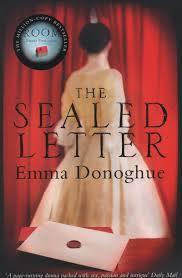
“It’s quite mysterious to Fido, that electric chain of feeling that can link two women of different ages, backgrounds, temperaments; that throb of sympathetic mutuality, that chiming note outside the range of men’s hearing. Without understanding it, she’s always responded to it as a diviner to the call of water deep underground.” Emma Donoghue, THE SEALED LETTER
THE SEALED LETTER by Emma Donoghue was published in 2008 and is 464 pages. I received the book as a gift from one of my writing critique partners, Jennifer Lyn King, because she knows how much I love historical fiction, how much I loved Donoghue’s ROOM, and because it parallels themes in my new WIP. Needless to say, Jennifer knows me very well because this book kept me up late on subsequent nights and I loved it.
Set in Victorian London, THE SEALED LETTER begins when two old friends, an unhappily married woman named Helen and her spinster friend Emily (whom she “affectionately” refers to as Fido), run in to one another in the street, and return to a deep and seemingly mutual affection they had once abandoned. It soon becomes clear, however, that Helen wishes to take advantage of Fido’s loyal nature, and enlists Fido to help her carry on an affair with an army officer in her husband’s corps.
After a series of careless and fateful meetings, Helen is soon on the defense in a scandalous divorce trial, and Fido is horrified to find herself in the middle of it. As Fido desperately tries to keep up her work at her women’s suffrage periodical, and to free herself of the charms of her old friend, and the sticky web of lies she has woven, Fido becomes more and more entangled.
With its salaciousness and scandal, THE SEALED LETTER, reminds one of a Jane Austen novel without censor. The period details are rich and allow the reader to imagine the setting with ease, and the sharp dialogue and plot twists are truly gasp-worthy. What is also fascinating is the fact that this novel is based on a true story.
Keep your smelling salts handy if you shock easily, but do read this book if you enjoy compelling “gossip fiction” of the highest quality. Fans of Downton Abbey will love THE SEALED LETTER.


December 16, 2012
Best Reads of 2012
This was indeed a magical year of reading, and it was agony picking a top ten list. As I’ve explained in the past, I only use the blog to recommend books I love, which means that there are many books I read which do not make the blog. I also deal almost exclusively in historical fiction, but that said, one book made my list this year that is not historical fiction (Shine, Shine, Shine.)
Without further ado, before I can change my mind again, and in no particular order, here is my list of favorite books read in 2012. If you click on each link, it will take you to the corresponding review.
1. Beautiful Ruins, Jess Walter
2. The Lost Wife, Alyson Richman
3. The Lighthouse Road, Peter Geye
6. Shine, Shine, Shine, Lydia Netzer
7. The Chaperone, Laura Moriarty
8. The House I Loved, Tatiana de Rosnay
9. The Care and Handling of Roses with Thorns, Margaret Dilloway
Have you read any of these books? What are your favorites of 2012?


December 13, 2012
Book Review: IN NEED OF A GOOD WIFE
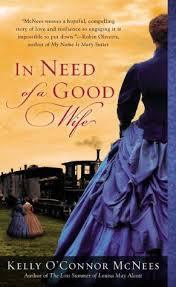
“The world is full of Rowenas, women who could cut you to the quick with their cruel appraisals of what they think you are. You have to know your own sacredness in order to endure them.” Kelly O’Connor McNees, In Need of a Good Wife
In Need of a Good Wife by Kelly O’Connor McNees was published in October of 2012 and is 400 pages. I “met” Kelly on Twitter and enjoy her quick wit and her taste in books, so I decided to read her novel, which I loved.
In post-Civil War New York, three women are imprisoned by their lives or pasts. From heartbreak and loss, to the alienation of being a poor immigrant, they find that they have nothing left to lose, so why not embark upon an adventure to the west?
The primary protagonist, Clara Bixby, works in the bar her father used to own, and is abandoned by her philandering husband. Elsa is a kind, lonely immigrant who is tired of working for the upper class, with no life or freedom of her own. Rowena is a feisty war widow with a mentally ill father and more debt than she can manage.
When Clara learns about a town in faraway Nebraska with an overpopulation of men and not enough women to tame its inhabitants, she devises a scheme to play matchmaker. Through a series of letters and newspaper ads, Clara attempts to find wives for these hard edged and hard up men, but gets more trouble than she bargained for.
From an unforgettable train ride west, a series of mismatches and misfits, and a town scandal, In Need of a Good Wife kept me turning pages long into the night. I read about the development of this area with interest, and was surprised many times by plot twists. The voices of each of the women in the novel are distinct and captivating, and even the scoundrels are human.
If you enjoy historical novels that illuminate little known places in the past and feature strong, fearless women, I highly recommend In Need of a Good Wife.
Purchase the novel or learn more about the author here:
http://kellyoconnormcnees.com/blog
Indiebound
B&N
Kindle
Nook
December 3, 2012
Book Review: BEAUTIFUL RUINS
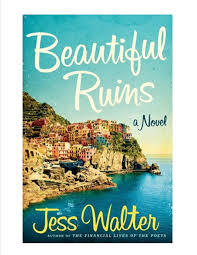
“‘All we have is the story we tell. Everything we do, every decision we make, our strength, weakness, motivation, history, and character–what we believe–none of it is real; it’s all part of the story we tell. But here’s the thing; it’s our goddamned story.’” Jess Walter, BEAUTIFUL RUINS
BEAUTIFUL RUINS by Jess Walter was published in June of 2012 and is 352 pages. I’ve read many outstanding reviews of the book and could no longer ignore the Twitter buzz and “Best of” lists mentioning it. I’ve been waiting to make my “Best of…” reading list for the year, and I’m glad I did, because this novel might very well be #1.
Set in the present day and in the past in Hollywood and Italy, BEAUTIFUL RUINS is the story of a small group of men and women whose lives become entangled and forever joined from a scandal on the set of the legendary Burton and Taylor film, CLEOPATRA.
The epicenter of the novel occurs on the coast of Italy in a forgotten town where a young man dreaming of becoming a hotelier and transforming his forgotten land into a tourist destination meets a dying actress who comes to stay with him. The time they spend together has a profound effect on both of their lives.
BEAUTIFUL RUINS is told from the perspective of many different characters at different phases of their lives. From the highs and lows, wealth and poverty, loves and losses, what I found most fascinating about the novel was the change in tempo and unique perspective each section brought the the book. Fiction doesn’t often have a beat, but this novel does, and you can’t help but get swept away in its rhythm.
I entered into the reading of BEAUTIFUL RUINS as a writer intending to study why it is so popular. Over and over again, however, I became so deeply lost in the story, the locales, and the interior lives of the characters, I couldn’t remember why I was reading or even that I was reading. Think of every entrance point into the book as a rocky ledge of Italy’s Cinque Terre–once you begin the ascent or descent, the views are captivating and hypnotic.
Profoundly human and moving, BEAUTIFUL RUINS, explores themes of redemption and second chances. It is an epic tale of the resonance of choice and circumstance that can be enjoyed by readers of all kinds of fiction.
If you are looking for a great read for yourself or another this holiday season, I give BEAUTIFUL RUINS my highest recommendation.












